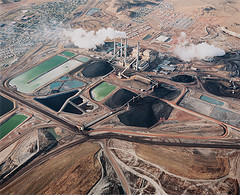Attention Puget Sound Energy customers: Don’t feel bad if you missed the connection between your electricity bills and today’s headlines about reducing air pollution in scenic Montana. It’s not obvious. But news that the federal government wants owners of the Colstrip coal plant to invest in expensive new equipment to reduce a fraction of its dirty emissions does affect more than 1 million electricity users in Washington State.
That’s because Puget Sound Energy owns the biggest chunk of the power (and the pollution) coming from the Colstrip coal plant in eastern Montana, which is the second-largest coal-fired power plant west of the Mississippi. Last year it released nearly 19,000 tons of nitrogen oxide and 16,000 tons of sulfur dioxide, which form smog or haze that’s unhealthy to breathe and obscures landscapes.
The Environmental Protection Agency has released a new plan that would require Colstrip’s owners to spend $82 million up front, and pay more than $14 million in annual costs, to meet haze standards that protect visibility in the state’s national parks and scenic areas. Puget Sound Energy owns half of the two coal-fired burners that need upgrades under the haze rules (and, unless it works out some kind of deal with other owners, seems like it would be liable for half the costs).
Put simply, older coal plants are too dirty to meet modern air pollution regulations. As anyone who has ever tried to nurse their car towards 200,000 miles can attest, there comes a point where you have to decide whether to keep sinking money into repairs or just get rid of it. All the fixes you need to make—a new clutch, cracked CV boots, old struts, bad wheel bearings—no longer make sense based on the useful life left in the car.
For Colstrip, Montana’s haze plan offers the first glimpse at the calculus that coal plant owners across the country are doing. Aside from the haze improvements that PSE is now officially on the hook for, the universe of potentially costly liabilities for utilities that own coal plants now includes: new rules to regulate toxic coal ash and ponds that occasionally give way and destroy downstream communities, rules to control mercury and other toxic metals, contamination from mining, and future strategies that would put a price on climate-warming gases that coal plants spew in massive quantities.
Rather than patch together hundreds of millions of dollars worth of band-aid strategies to meet the new rules, some utilities have decided it’s just not worth it. They’d rather spend their energy (and, presumably, ratepayers’ money) on figuring out how to responsibly transition off of dirty coal power.
Take Portland General Electric, for instance. It faced the possibility of having to invest $500 million at its Boardman coal plant to reduce haze pollution. After several years of negotiations, it reached an agreement with the state of Oregon to install a much less expensive suite of equipment ($60 million to control mercury, NOx and SO2) in exchange for shutting the coal plant down in 2020, two decades early.
Compared with $500 million, the $80 million in capital investment that the EPA is asking for at Colstrip may not seem like a big number. But, as Oregon’s negotiations show, those costs can balloon or shrink by a wide margin depending on how the laws are interpreted. Already, groups have expressed disappointment with the Montana haze plan.
Health advocates estimate that Colstrip produces almost twice as much smog-causing pollution as the next nine biggest polluters in the state, and causes an estimated 31 deaths, 47 cases of acute bronchitis, 48 heart attacks, 534 asthma attacks and 31 asthma emergency room visits every year. They will certainly argue for more protective pollution controls during the federal review process and would have every right to challenge weaker rules in court.
That’s because there are a number of different technologies available, with widely different price tags and degrees of effectiveness. For instance, the EPA’s plan considered three different technologies to reduce NOx pollution from Colstrip’s two older stacks, with up-front costs ranging from $9 million for a relatively simple fix to $164 million for a state-of-the-art solution that includes selective catalytic reduction (SCR) technology. That would have reduced emissions from the plant’s two older burners by 6490 tons. But the EPA decided on a middle option that would cost $26 million and eliminate 4194 tons of emissions.
To reduce SO2 emissions, the EPA weighed two different technologies that would require capital investments of $6 million and $56 million, respectively. In that case, the regulators decided that the benefits from adding more expensive scrubbers (which would eliminate 8972 tons vs. 6714 tons for the cheaper option) were significant enough to justify the price tag.
With such a huge range of potential costs in play—and possibly more on the way—betting on coal as a continued cheap source of energy is risky. And it can require significant lead time and planning for a utility to replace a large chunk of coal power with cleaner options. That’s why it’s important to ask now about whether using money from Washington’s customers to prop up an antiquated coal plant in Montana really makes any sense.
FYI – Montana’s haze plan will be subject to two public hearings in May, and to public comment.


Comments are closed.